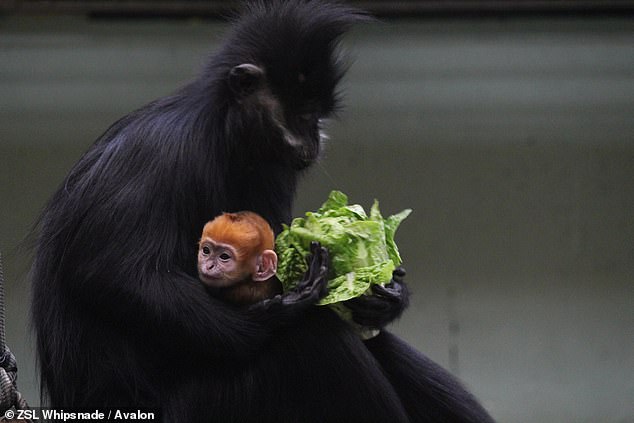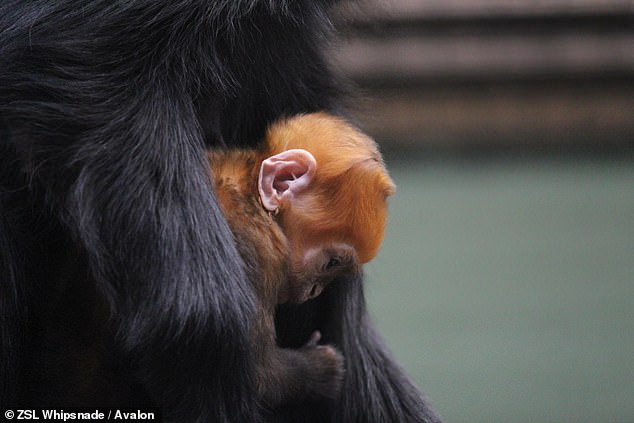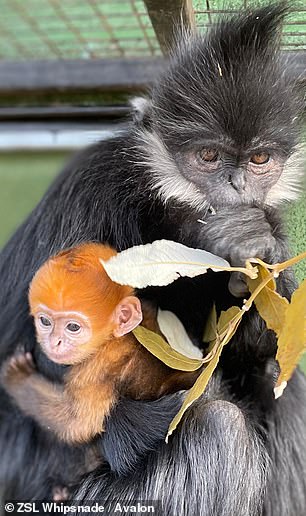Orange is the new black! Adorable monkey with bright red fur is born in a zoo in Bedfordshire, despite both parents being monochromatic
- Whipsnade Zoo is now home to a week-old langur monkey
- Babies are born with distinctive orange hair, but turn black as they grow older
A baby monkey with bright orange fur and described by keepers as a ‘ray of sunshine’ has been born at a protected zoo in Bedfordshire.
Whipsnade Zoo is now home to a one-week-old François’ langur, who was born to mother Lulu and father Wang in the early hours of February 17.
In contrast to the monochromatic coats of adult François langurs, babies are born with shocking orange hair, with images showing the flame-colored newborn cuddling in its mother’s dark black fur.
The monkey’s birth has been described as a ‘sign of hope’ for its endangered species.
A baby monkey with bright orange fur and described by keepers as a ‘ray of sunshine’ has been born at a zoo in Bedfordshire

In contrast to the monochromatic coats of adult François’ langurs, babies are born with shocking orange hair, with photos showing the flame-colored newborn cuddling in its mother’s dark black fur.
Whipsnade zookeeper Amanda Robinson said the team was thrilled to see Lulu cradling her bright orange baby.
“It is believed that the babies are born with bright orange locks so that parents can easily recognize the child when being cared for by the troop,” she said.
‘Over time this hair will turn black.
‘The bright orange hair certainly makes it easier for caregivers and visitors to spot the new addition!’
François’ langurs are native to China and northern Vietnam and are listed on the IUCN Red List of Threatened Species as Endangered. Their numbers continue to decline in the wild, making the recent birth internationally important.
“Sadly, the number of François’ langurs in the wild is declining, so this newborn is truly a ray of sunshine and a sign of hope for the species,” Ms Robinson said.

Whipsnade zookeeper Amanda Robinson said the team was ecstatic to see Lulu cradling her bright orange baby

François’ langurs are native to China and northern Vietnam and are listed as endangered on the IUCN Red List of Threatened Species. Their numbers continue to decline in the wild, making the recent birth internationally important.

Conservationists estimate that only 2,000 of these primates remain in the wild
In François’ langur habitat, big sister Nguyen also cares for the newborn, because she wants to share parental responsibilities with mother Lulu.
“Nguyen stays close to her mother Lulu and gives her a break when she needs to eat or drink,” Mrs Robinson said.
‘She treats the newborn as if it were her own baby, which is exactly what you would see in the wild. It shows that the eight-year-old has picked up some great skills from the older members of the troop.”
The child was born as part of a European Endangered Species Breeding Program (EEP), an internationally coordinated conservation initiative that aims to increase the number of species threatened in the wild.
Conservationists estimate that only 2,000 of these primates remain in the wild, because the species is threatened by illegal hunting for their meat and for traditional medicinal purposes.
– The langur troop can be found in Whipsnade Zoo’s new Monkey Forest, which opens to the public on March 29.
